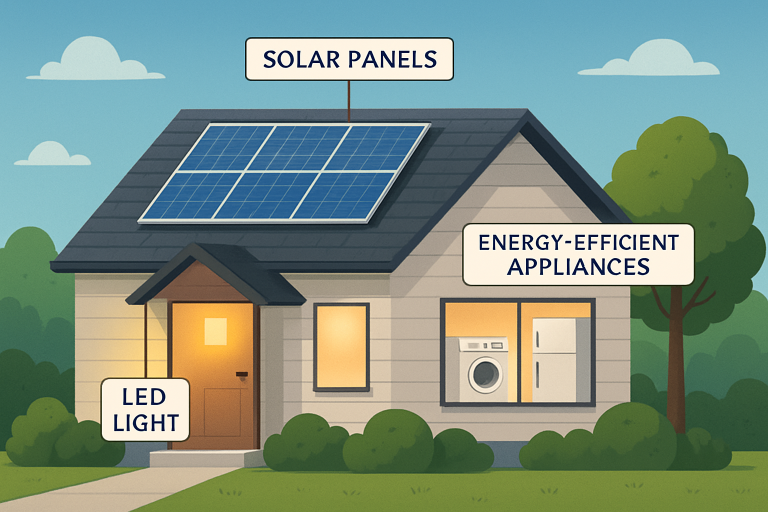Eco-friendly living is rapidly becoming a top priority for today’s homebuyers. As sustainability awareness rises, even modest green upgrades can make your property stand out in a competitive real estate market. Whether aiming for a faster sale, a higher offer, or both, investing in your home’s environmental performance can yield impressive returns. There are various ways to enhance your home’s sustainability—many of which are straightforward and cost-effective. Prioritizing these improvements not only helps the planet but also gives your listing a distinct edge. If you’re considering selling soon in the Seattle area, a West Seattle real estate expert can advise you on the green features local buyers value most. New technologies and materials are enhancing the potential for reducing utility bills and appealing to eco-conscious buyers. As eco-friendly upgrades become essential, these enhancements will improve a home’s integrity and marketability. Homes with green certifications not only sell for higher prices but also spend less time on the market, making the promotion of a property’s environmental features both trendy and practical.
Upgrade to Energy-Efficient Appliances
Modernizing your appliances is one of the easiest and most visible ways to boost your home’s sustainability profile. ENERGY STAR-certified appliances use significantly less energy and water, helping owners cut utility bills and shrink environmental impact—key selling points for today’s buyers. For example, replacing an old refrigerator with an ENERGY STAR option can use about 9% less energy than standard models. Updating your washer, dryer, dishwasher, and oven will also make your listing more appealing to eco-focused shoppers.
Install Smart Thermostats
Smart thermostats optimize comfort and energy efficiency by learning your routines and adjusting home temperatures accordingly. They often come with Wi-Fi connectivity, allowing homeowners to control heating and cooling from anywhere via a mobile app. Besides monthly savings, tech-savvy buyers appreciate the convenience and modernization a smart thermostat brings. According to the U.S. Department of Energy, these devices can reduce heating and cooling costs by up to 10%. Explore more about programmable and smart thermostats via the U.S. Department of Energy website.
Enhance Insulation and Seal Drafts
If your home feels drafty or your utility bills seem high, improving insulation and sealing leaks offers a significant opportunity to reduce energy loss. Focus on attics, exterior walls, crawl spaces, and around windows and doors for maximum effect. Proper insulation ensures consistent indoor comfort and can result in marked savings, with the Department of Energy reporting up to 20% lower heating and cooling bills. Simple improvements, such as weather stripping, caulking, and adding attic insulation, have a significant impact on efficiency.
Switch to LED Lighting
Making the switch to LED lighting throughout the house is a quick, affordable improvement with immediate benefits. LEDs use up to 75% less energy than old incandescent bulbs and often last more than 25 times longer. This lowers both your electricity bill and your home maintenance needs—a win-win that future buyers will notice. The long lifespan of LEDs also means fewer bulb changes and less waste over time.
Consider Solar Panel Installation
Solar panels have gone from a rare luxury to a highly desirable feature, especially in sunny areas or markets with good incentives. They lower reliance on the grid, cut monthly electricity costs, and boost resale value. Plus, homeowners might qualify for rebates or tax credits, making installation more affordable than ever. Homes with solar often sell faster and for higher prices in many regions. Make sure to check local incentives and rules before installing.

Implement Water Conservation Measures
Installing low-flow toilets, faucets, and showerheads is a cost-effective step toward sustainability, as it reduces both water waste and utility expenses. Consider adding rainwater collection systems for lawn irrigation, which appeals to buyers who are eager to reduce their environmental footprint. Smart irrigation controllers and drought-resistant landscaping further boost your property’s green appeal.
Use Sustainable Building Materials
Eco-friendly building materials, such as bamboo flooring, recycled glass countertops, and reclaimed wood, not only add aesthetic character but also environmental integrity to your space. These choices often offer comparable durability to traditional materials, with the added benefits of lower emissions and reduced resource depletion. Beyond flooring, look into recycled insulation, paints with low VOCs, and cabinets made from renewable sources.
Highlight Sustainable Upgrades in Marketing
Once your green improvements are in place, spotlight them in your marketing efforts. List all sustainable features in your property description and be ready to provide documentation or utility bill comparisons to show the impact of your upgrades. Consider including any certifications or warranties in your listing package, which reassures buyers about long-term savings. Homes marketed with green or energy-efficient features attract more attention and command higher prices, especially in competitive, climate-conscious markets.
Making your home more sustainable before selling is a smart strategy for today’s market. Environmental upgrades not only make a positive difference but also help your property shine—leading to a faster, higher-value sale while investing in a better future for both your family and the planet.